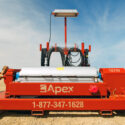
Your drilling mud centrifuge is essential for eliminating fine and ultrafine solids from your drilling fluids. It not only reduces fluid consumption and waste but also sets the stage for an effective fluid management system.
To achieve optimal efficiency with your drilling mud centrifuge, start with:
- Embracing superior technology—that’s why we choose Alfa Laval.
- Implementing integrated variable speed control instead of traditional valve flow control to lower system pressure and conserve energy.
- Using Super Duplex Stainless Steel construction to attain the industry’s highest G-force for maximum separation efficiency.
We’re passionate about refining the centrifuge process because it’s the cornerstone of your fluid management system.
Selecting the Right Drilling Mud Centrifuge
Several factors influence the ideal centrifuge for your operation, including local regulations on fluid and cuttings, drilling speeds, and drill bit types. Making the right selection will boost your uptime and reduce costs.
An effective centrifuge should proficiently separate fluids and solids, conditioning your drilling mud to meet top-tier process and environmental standards. When operating at peak performance, a drilling mud centrifuge will:
- Lower total drilling fluid consumption.
- Enhance drilling fluid effectiveness.
- Allow for the reuse of drilling mud.
- Cut down on waste disposal expenses.
- Increase compliance with environmental guidelines.
Whether you need to rent a single drilling mud decanter centrifuge or require a fully staffed, multi-product central fluid processing facility, our experts are here to provide the right equipment and technical support for your project.
Access the best technology.
For on-site solutions, we combine Alfa Laval’s technology with our proprietary solids control equipment—including hydraulic centrifuge stands, fluid management tanks, centrifuge floc tanks, and stripping centrifuge floc tanks—to deliver turnkey fluid management systems.
Explore our range of drilling mud centrifuges to review models, process capabilities, throughput rates, and process control options.




